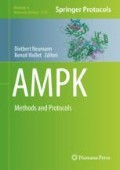Abstract
Unraveling the spatiotemporal dynamics of 5'-AMP-activated protein kinase (AMPK) signaling is necessary to bridge the gap between nutrient signaling and downstream function. Three genetically encoded Förster Resonance Energy Transfer (FRET)-based AMPK biosensors are available yielding insight into how AMPK-derived signal propagates throughout a cell in response to particular inputs. These findings, together with accumulating evidence obtained from biochemical techniques, promise to give a holistic understanding of the AMPK signaling. In this protocol, we describe the procedures and materials required for imaging intracellular AMPK activity in an organelle-specific manner, with a focus on ABKAR, a FRET-based biosensor. In addition, we introduce a novel AMPK inhibitor peptide that allows us to inhibit AMPK activity at specific subcellular compartments.
Access this chapter
Tax calculation will be finalised at checkout
Purchases are for personal use only
References
Hardie DG, Ross FA, Hawley SA (2012) AMPK: a nutrient and energy sensor that maintains energy homeostasis. Nat Rev Mol Cell Biol 13:251–262
Shackelford DB, Shaw RJ (2009) The LKB1-AMPK pathway: metabolism and growth control in tumour suppression. Nat Rev Cancer 9:563–575
Xiao B, Sanders MJ, Underwood E et al (2011) Structure of mammalian AMPK and its regulation by ADP. Nature 472:230–233
Oakhill JS, Steel R, Chen Z et al (2011) AMPK is a direct adenylate charge-regulated protein kinase. Science 332:1433–1435
Woods A, Johnstone SR, Dickerson K et al (2003) LKB1 is the upstream kinase in the AMP-activated protein kinase cascade. Curr Biol 13:2004–2008
Hawley SA, Pan DA, Mustard KJ et al (2005) Calmodulin-dependent protein kinase kinase-beta is an alternative upstream kinase for AMP-activated protein kinase. Cell Metab 2:9–19
Woods A, Dickerson K, Heath R et al (2005) Ca2+/calmodulin-dependent protein kinase kinase-beta acts upstream of AMP-activated protein kinase in mammalian cells. Cell Metab 2:21–33
Schaffer BE, Levin RS, Hertz NT et al (2015) Identification of AMPK phosphorylation sites reveals a network of proteins involved in cell invasion and facilitates large-scale substrate prediction. Cell Metab 22:907–921
Medints I, Hildebrandt N (2013) FRET – Förster Resonance Energy Transfer: from theory to applications. Wiley Online Library. http://onlinelibrary.wiley.com/book/10.1002/9783527656028
Tsou P, Zheng B, Hsu C-H et al (2011) A fluorescent reporter of AMPK activity and cellular energy stress. Cell Metab 13:476–486
Miyamoto T, Rho E, Sample V et al (2015) Compartmentalized AMPK signaling illuminated by genetically encoded molecular sensors and actuators. Cell Rep 11:657–670
Miyamoto T, Rho E, Inoue T (2015) Deconvoluting AMPK dynamics. Oncotarget 6:30431–30432
Sample V, Ramamurthy S, Gorshkov K et al (2015) Polarized activities of AMPK and BRSK in primary hippocampal neurons. Mol Biol Cell 26:1935–1946
Depry C, Mehta S, Li R, Zhang J (2015) Visualization of compartmentalized kinase activity dynamics using adaptable BimKARs. Chem Biol 22:1470–1480
DeRose R, Miyamoto T, Inoue T (2013) Manipulating signaling at will: chemically-inducible dimerization (CID) techniques resolve problems in cell biology. Pflugers Arch 465:409–417
Komatsu T, Inoue T (2014) A method to rapidly induce organelle-specific molecular activities and membrane tethering. Methods Mol Biol 1174:231–245
Kodiha M, Rassi JG, Brown CM, Stochaj U (2007) Localization of AMP kinase is regulated by stress, cell density, and signaling through the MEK-->ERK1/2 pathway. Am J Physiol Cell Physiol 293:C1427–C1436
Fivaz M, Bandara S, Inoue T, Meyer T (2008) Robust neuronal symmetry breaking by Ras-triggered local positive feedback. Curr Biol 18:44–50
Acknowledgments
We are grateful to Robert DeRose and Daniel Frigo for constructive comments. This work was supported in part by the US National Institutes of Health (NIH) grant to T.I. (DK102910).
Author information
Authors and Affiliations
Editor information
Editors and Affiliations
Rights and permissions
Copyright information
© 2018 Springer Science+Business Media, LLC
About this protocol
Cite this protocol
Miyamoto, T., Rho, E., Kim, A., Inoue, T. (2018). Cellular Application of Genetically Encoded Sensors and Impeders of AMPK. In: Neumann, D., Viollet, B. (eds) AMPK. Methods in Molecular Biology, vol 1732. Humana Press, New York, NY. https://doi.org/10.1007/978-1-4939-7598-3_17
Download citation
DOI: https://doi.org/10.1007/978-1-4939-7598-3_17
Published:
Publisher Name: Humana Press, New York, NY
Print ISBN: 978-1-4939-7597-6
Online ISBN: 978-1-4939-7598-3
eBook Packages: Springer Protocols

